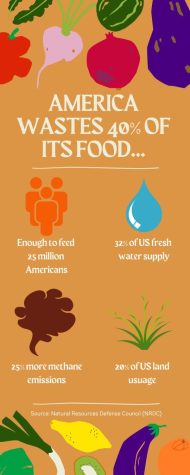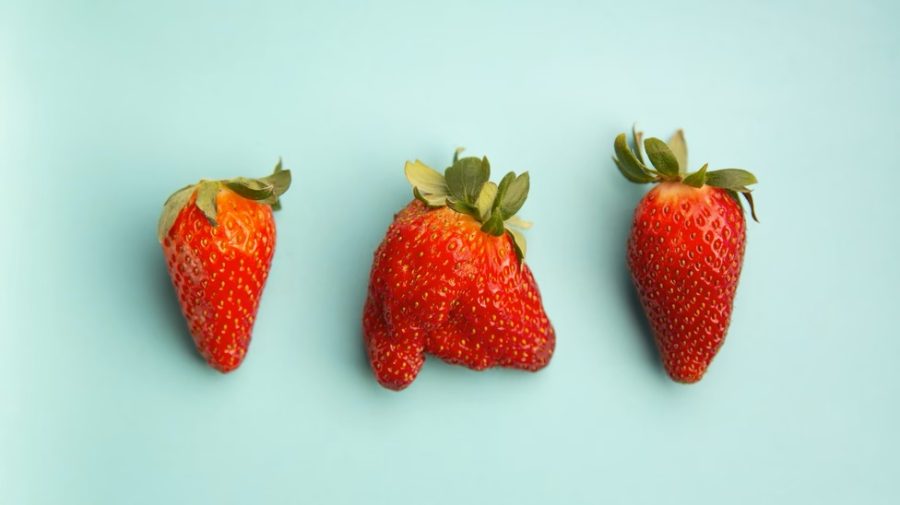The problem with throwing out edible food
Each year, millions of pounds of safe, edible produce ends up in landfills, not making it to grocery store shelves. Adhering to “food beauty standards” where blemished, misshapen or multicolored produce does not show up on the market results in millions of pounds of wasted food. The uneaten produce further exacerbates the growing climate issue of global warming. The resources and capital invested in each step of the food supply chain result in their misuse and end up wasted. By educating consumers on the impacts food waste presents, their purchasing decisions can cater to buying imperfect food.
May 16, 2023
On grocery store shelves, unblemished and monocolored produce line up on display. Before produce appears on the market, the accumulated waste throughout the food supply chain processes crops up. Every year, the United States produces 119 billion pounds of waste that consists of safe, edible food. In every step of the food production to suppliers, the commercial food sector comprises 61% of the amount of food wasted. Among the causes for this occurrence points to the aesthetic standards placed on provisions. The reasoning for trashing perfectly edible produce based on the impression of “food beauty standards” ignores the vast population that experiences food insecurity or lack of access to healthy produce. The billions of pounds wasted leaves a lasting, detrimental impact on the environment and misspend resources that contribute toward the whole food production process.
The aesthetic standards placed on produce include the characteristics of the size, color and shape. All of these traits do not affect the quality or edibleness of the product. Instead of throwing away food based on slight discoloration or shape deformities, saving these products could alleviate food insecurity that affects a mass amount of people within the United States. According to the USDA’s Economic Research Service, 33 million Americans lived in food-insecure households in 2021. Food insecurity can deepen as the U.S. population rises. The Congressional Budget Office projects the U.S. population will increase from 336 million in 2023 to 373 million in 2053. The existence of this type of food waste appears illogical if a sizable population suffers from a lack of food. Food that does not deem sellable due to cosmetic standards can nourish the U.S. population. “Ugly” produce could feed people who suffer from food insecurity who would benefit from the available food supply.
“The amount of food that is thrown out in the United States just comes to show how many people don’t really think of how other countries struggle with food insecurity and even this country, and instead are selfish on how they manage their food,” magnet junior Diego Carreras said.
Landfill and incinerators result as methods companies use to dispose of the compiled food waste. Landfills already present an environmental issue, but the appearance of produce in these dumping grounds contributes to escalating global warming. When produce rots, it releases methane, a greenhouse gas 25 times more potent than carbon dioxide. A substantial amount of food sits in landfills as a result of disposal from the produce industry. With California’s reputation as the produce capital in the United States, its produce industries send between four and eight million pounds of fresh vegetables to landfills. The millions of pounds rotting in piles accumulate into producing a massive amount of methane and exponentially increase the global warming effect.
Much like humans, plants require materials and supplies as they develop. The resources used to foster the growth of produce and the energy put in to transport the wasted produce as well. Uneaten, wasted food results in the usage of 300 million barrels of oil per year. The utilization of oil contributes to the global warming effect as well with oil releasing greenhouse gasses. The use of other resources misused include fertilizers, land and water, which all cost money as well. Monetary investments put into the steps of growing and transporting produce become misspent and contribute to US industries losing billions. According to the Natural Resources Defense Council (NRDC), the farming, processing, transporting and disposing of edible food rack up an estimated cost of $218 billion, 1.3% of the US Gross Domestic Product (GDP.)

Although companies may argue that imperfect produce does not appeal to consumers and in turn will not sell, educating consumers on the impact of food waste helps them create conscious decisions to buy food that would end up in landfills. Researchers from the University of Minnesota-Twin Cities found that awareness of food waste and its impacts persuade consumers to consider purchasing imperfect food. By providing the public with information about the safety of the edible blemished or multi-colored produce, the notion of consumers not indulging in flawed food no longer remains an issue.
“I think educating people on how imperfect food is still edible considering, for example, the number of bananas that are thrown out just because of their ‘bruises’ even though it’s still edible. Many people in the U.S. judge food based on its appearance, and not on if it’s actually edible or not,“ Carreras said.
Throwing away edible food on superficial standards such as the appearance of the food remains ignorant as it stands as the solution to the pressing issue of food insecurity. The millions of pounds of food put in wasteful landfills could feed the growing food-insecure population within the United States, especially by bringing accessible, healthier food to the table. Furthermore, the dismissal of perfectly edible food speeds up detrimental global warming and wastes billions of dollars. As the appearance of produce remains an issue to sellers and affects the marketability of the food, simply educating the public on food waste can positively influence the outlook on purchasing misshapen, blemished or discolored food.




